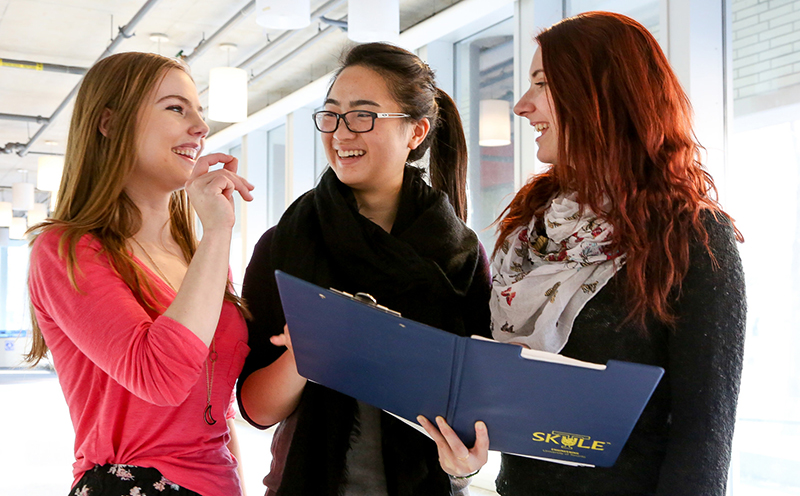January 28, 2014

Women now account for 30.6 per cent of first-year students in U of T Engineering programs: a record for the Faculty and a number that surpasses all other Ontario universities. It is the only engineering school in Ontario with female first-year enrolment of more than 30 per cent. National figures are expected later this year from Engineers Canada.
“U of T Engineering is a rich environment for talented, bright women to become engineering leaders,” said Dean Cristina Amon. “Diverse perspectives are the foundation of our culture of excellence in research, education, service and innovation. This achievement is encouraging as we continue our proactive efforts to foster diversity within the Faculty, among universities and across the engineering profession.”
Today, one quarter (25.8 per cent) of U of T Engineering’s undergraduate population is female, compared to a province-wide average of 19.7 per cent. Across Canada and the United States last year, those averages were 18.9 per cent and 19.9 per cent respectively. The Faculty’s targeted recruitment efforts have been successful, with female undergraduate enrolment up from 21.3 per cent just six years ago, alongside rising entrance grade averages for first-year students that reached a record 92.4 per cent this year.
“It’s exhilarating to be part of such a diverse and talented student community,” said Teresa Nguyen (CivE 1T4 + PEY), a fourth-year civil engineering student and president of the Faculty’s Engineering Society (which elected its first female president in 1975). “At U of T Engineering, it doesn’t matter what your background is—it’s about the ideas, expertise and reasoning you bring to the table.”
“My experience at U of T Engineering has been even better than I expected,” said Molly Gorman (ChemE 1T8), a first-year chemical engineering student who’s eyed U of T since before she started high school. “It’s incredible being a part of Canada’s best engineering school—and living in a city filled with so many opportunities!”
As a leader in engineering education and research, U of T Engineering continues to attract world-class faculty. The complement of female faculty members has more than doubled in the past eight years, from 21 in 2006 to 44 in 2014. Seventeen per cent of faculty members are women, which is three points higher than the Ontario average (14 per cent) and four points higher than the Canadian average (13 per cent).
These numbers are expected to grow in the years ahead, as early-career faculty members move up in the academic ranks. More than a quarter (27.8 per cent) of U of T Engineering’s associate professors (early-career, tenure-stream faculty members) are now women, compared to an Ontario average of 15 per cent and a national average of 15.7 per cent.
In the 2014–15 academic year, women accounted for three of the four new faculty members hired at U of T Engineering. In addition, all three of the Faculty’s 2014 Canada Research Chairs are women; read more about U of T Engineering’s newest professors and Canada Research Chairs.
“Engineering has changed significantly from when I began at U of T several decades ago,” said Professor Susan McCahan(MIE), U of T’s new vice-provost, innovations in undergraduate education, who was the University’s first female faculty member in mechanical engineering. “It is increasingly recognized as a vibrant and innovative profession: one that encourages broad perspectives and collaboration to drive positive changes that improve our world.”
Inspiring a new generation of female engineers
“Amidst the increasing numbers of women entering Engineering programs, there is more work to be done in attracting women to the diverse and rewarding field of engineering,” said Dean Amon. “We have re-imagined engineering education by introducing program innovations, new resources for students and outreach activities to continue to attract an even more diverse range of applicants, including women.”
As of 2013, women accounted for just 11.7 per cent of all professional engineers in Canada. Growing numbers of female engineering students signal a promising future for gender balance in the profession.
Read more about U of T Engineering programming for female engineers.

Timeline for Women in Engineering at U of T
U of T Engineering has a long history of remarkable women. A few highlights:
1920: First female architect in Canada graduates from U of T Engineering
1927: First woman to graduate with an engineering degree from U of T
1958: First woman joins the Faculty’s permanent academic staff
See a timeline of the history of women in engineering at U of T.
More information:
Marit Mitchell
Senior Communications Officer
The Edward S. Rogers Sr. Department of Electrical & Computer Engineering
416-978-7997; marit.mitchell@utoronto.ca